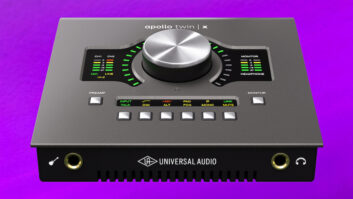
Montreal, Canada (May 12, 2021)—With the pandemic restricting travel late last year, a group of engineers collaborated remotely to record orchestral re-interpretations of songs by 1970s French-Canadian folk-prog band Harmonium. Histoires sans paroles – Harmonium Symphonique draws from the band’s three studio albums to present more than two hours of music performed by the 68-piece Orchestre symphonique de Montréal (OSM) and choir.
Rick Winquest, based in California, had been scheduled to spend up to four weeks in Montreal as the recording engineer and sound consultant. When COVID-19 stymied that plan, it fell to Charles-Émile Beaudin, working in the Piccolo Mobile recording truck at Montreal’s 1,900-seat Maison Symphonique (Symphony House), to track the project.
The project was orchestrated by music arranger Simon Leclerc, who co-produced the album with Serge Fiori, Harmonium founder and leader, under the artistic direction of Nicolas Lemieux, president of record label GSI Musique. Winquest, who first worked with Leclerc on Star Trek at Paramount Pictures in Hollywood and was mentored by legendary scoring engineer Danny Wallin at the lot’s Record Plant-owned Studio M, monitored the sessions from his office in Santa Clarita.
Beaudin brought in microphones by Neumann, Sennheiser, Schoeps, Sanken, Royer, Microtech Gefell, Coles, Brauner and AKG from Studios Piccolo and his own collection. Apart from close-miking solo guitar, harp and celeste, says Winquest, “The main concept was distance-miking techniques: Decca tree and wide room and section placements. Symphony House has such astounding acoustics that of course we needed to work with the natural ambience of the room to make the instruments sound bigger than life.”
Beaudin also subsequently mixed the tracks at Studios Piccolo in Montreal, again working remotely with Winquest. Throughout the project, the pair communicated in real-time through Google Docs and Zoom, including with orchestra contractor François Pilon, while Winquest monitored via Audiomovers streaming software.
To monitor during the sessions, Winquest employed a Focusrite D-to-A feeding his Bryston amps and PMC IB1S speakers. “Charles used PMC speakers for monitoring also, so we had fairly equal listening environments,” he says.
[media-credit name=”SIMON GOULET” align=”left” width=”726″] [/media-credit]
[/media-credit]
With coronavirus protocols in place, Winquest also helped design a 20-foot extension to the concert hall’s stage to accommodate the OSM with social distancing. “Normally, two violins would be around one music stand. Now, each had their own stand and they were two meters apart, so we needed more space,” he says.
Released in December 2020 by GSI Musique, the album was already certified Platinum—solely from physical and digital download sales—in February.
Top Guitar Miking Tips—How to Capture a Roaring Guitar Amp
Winquest worried that, with the orchestra so spread out, timing and delay might be a problem. But conductor Leclerc ably kept everyone in sync, he says. As for the environment, “We brought in a load of baffles and gobos so that we could have more control over the instruments and the acoustics of the stage and room.”
In the end, the only real challenge was a resonant frequency in the hall, he says. “For live performance that’s not a huge problem, but when recording it amplifies and can really poke out.”

Winquest developed a process with Beaudin for the mix sessions, listening to files downloaded from Dropbox then exchanging notes using spreadsheets in Google Docs. “We fine-tuned this process so that Charles could look at all of my comments with song timing locations and such. Each tab was a different song with timings notated for easy location of mix fixes.”
Delays to the project due to the pandemic also hastened the deadline, says Beaudin. “The time to mix was shrinking every day, and there was a lot to do—two hours and 15 minutes of music. Just by myself I would have gone crazy. So Rick was a really helpful second pair of ears. That helped me go through the process at that speed. And he’s amazing; all of his tips were great.”
While never quite clicking with American audiences, who were not used to listening to French language songs, Harmonium still found a place in the prog rock pantheon. The band’s 1975 album, Si on avait besoin d’une cinquième saison (also known as The Five Seasons), was described by Rolling Stone as “the pinnacle of the whole Folk-Prog movement.” In 2015 it landed in the magazine’s list of the 50 best progressive rock albums of all time.
The band certainly has a place in many Canadians’ hearts, says Beaudin. “Harmonium’s music is in the blood of every Québécois. Some say that if Québec was a country the anthem would probably be a Harmonium song.”
Harmonium Symphonique • www.harmoniumsymphonic.com







